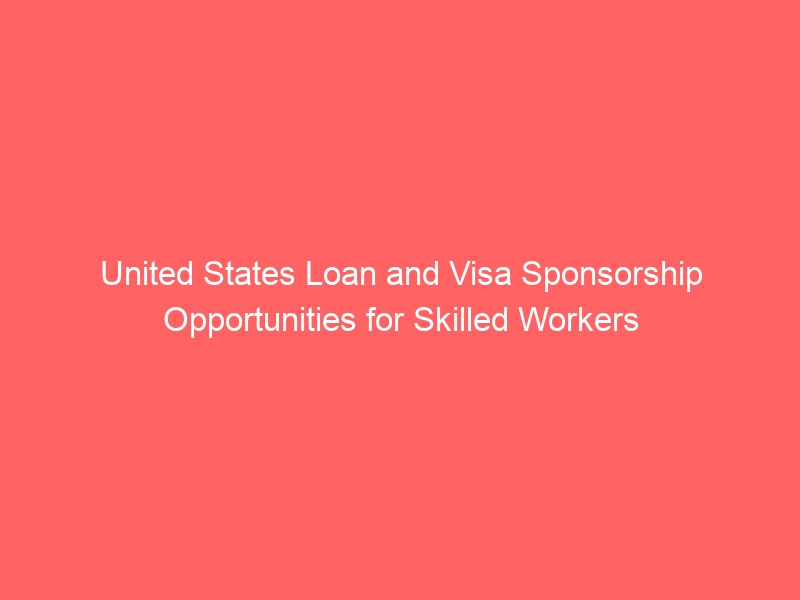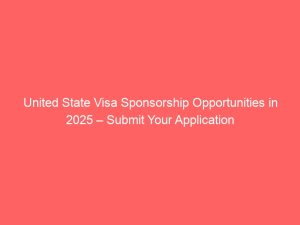The United States continues to be one of the most attractive destinations for skilled workers seeking better career prospects, higher earnings, and a better quality of life. For many professionals around the world, the dream of working in the U.S. comes with two main challenges: securing a visa sponsorship and obtaining financial support through loans. Visa sponsorship ensures that a U.S.-based employer or organization legally supports your application to work and live in the country, while loan opportunities can help you manage relocation costs, housing expenses, tuition fees, or even business ventures. Understanding how these two elements work together can significantly improve your chances of successfully starting a career in the United States.
Understanding Visa Sponsorship in the United States
Visa sponsorship is the process by which a U.S. employer or institution agrees to petition the United States Citizenship and Immigration Services (USCIS) on behalf of a foreign worker. The sponsor takes legal responsibility for your stay and often covers some immigration-related costs. For skilled workers, visa sponsorship is usually linked to specific visa categories such as the H-1B visa, the O-1 visa for individuals with extraordinary ability, and the EB-3 visa for skilled or professional workers.
Visa sponsorship is essential for non-U.S. citizens because, without it, you cannot legally work in the country unless you have a green card or another form of permanent residency. Sponsorship also gives credibility to your application since it shows that a legitimate employer in the U.S. values your skills enough to navigate the immigration process on your behalf.
Types of Visa Sponsorship Available for Skilled Workers
Several visa categories support skilled workers, each with specific requirements:
H-1B Visa
This is the most common work visa for skilled workers in specialized fields such as IT, engineering, healthcare, finance, and education. The employer must prove that the position requires a highly skilled individual and that there are no qualified U.S. workers available to fill it.
EB-3 Visa
The EB-3 category is for skilled workers, professionals, and certain unskilled workers. Unlike the H-1B, the EB-3 visa can lead to permanent residency, making it an attractive option for those who want to settle in the U.S.
O-1 Visa
The O-1 visa is for individuals with extraordinary ability in fields like science, education, business, arts, or athletics. Skilled workers with significant achievements in their industries may qualify for this visa.
TN Visa
For Canadian and Mexican professionals, the TN visa provides an easier route to work in the United States under the USMCA agreement.
How Loan Opportunities Fit into the Process
Moving to the United States as a skilled worker can be expensive. Expenses may include visa application fees, travel costs, relocation services, housing deposits, and living expenses for the first few months before receiving your first paycheck. This is where loan opportunities become relevant. Loans can be taken for various purposes, such as:
- Relocation and travel expenses
- Housing and rental deposits
- Tuition and education costs if further studies are required
- Setting up a small business in the U.S.
- Covering family relocation expenses
Types of Loans Available for Skilled Workers Moving to the U.S.
Several loan types are available for skilled workers who receive visa sponsorship:
Personal Loans
Many banks and credit unions in the United States offer personal loans to skilled workers, even those who are new to the country, provided they have an employer-sponsorship letter and proof of income.
Relocation Loans
Some financial institutions have special relocation loan packages designed for individuals moving for work. These loans often cover moving services, flights, and initial accommodation.
Education Loans
If your career advancement requires further studies or certifications in the United States, education loans can help cover tuition fees and related costs.
Business Loans
Entrepreneurial skilled workers may consider business loans if they plan to start or buy into a business after relocating to the U.S. Visa sponsorship, in this case, might come from an investment-related visa like the E-2 visa.
How Visa Sponsorship Can Improve Loan Approval Chances
Visa sponsorship can increase your credibility with U.S. lenders. When a legitimate U.S.-based employer sponsors your visa, it shows that you have a stable job waiting for you in the country. This reduces the lender’s perceived risk since your employment makes it more likely you will be able to repay the loan. Additionally, some employers have partnerships with banks or credit unions that provide relocation loans at lower interest rates to sponsored employees.
Step-by-Step Guide to Securing Loan and Visa Sponsorship
To maximize your chances of securing both a loan and visa sponsorship, you need a clear plan:
Step 1: Identify Your Skills and Target Industries
Understand what skills you have that are in demand in the U.S. The most in-demand fields often include information technology, engineering, healthcare, finance, skilled trades, and education.
Step 2: Search for Employers Who Offer Visa Sponsorship
Look for job postings that explicitly mention visa sponsorship availability. Many multinational companies and U.S.-based firms hire international talent and cover sponsorship costs.
Step 3: Apply and Get an Offer Letter
Once you secure a job offer from a sponsoring employer, request an official letter stating your role, salary, and confirmation of visa sponsorship.
Step 4: Research Loan Providers
Research U.S. banks, credit unions, and international lenders that cater to newly arriving workers. Compare interest rates, repayment terms, and eligibility requirements.
Step 5: Prepare Documentation
Gather all necessary documents, such as your employment contract, visa sponsorship letter, proof of income, and identification. If the loan is from a U.S. bank, you may also need to provide proof of residency or an address.
Step 6: Apply for the Loan
Submit your loan application along with all supporting documents. Some lenders allow you to apply before moving, while others require you to be in the country.
Step 7: Relocate and Begin Work
Once your visa is approved and your loan is disbursed, make your move. Ensure you budget carefully to cover initial months in the U.S.
Common Challenges and How to Overcome Them
Even though opportunities exist, you may face certain challenges:
Credit History Limitations
New immigrants often do not have a U.S. credit score, which can make it harder to secure loans. To overcome this, seek lenders that accept international credit histories or proof of employment.
Limited Employer Sponsorship Availability
Not all U.S. employers are willing to go through the process of sponsoring visas. To increase your chances, focus on industries experiencing labor shortages and companies with a history of sponsoring foreign workers.
High Loan Interest Rates
Without a U.S. credit score, interest rates may be higher. To reduce costs, negotiate with the lender, use a co-signer if possible, or choose shorter repayment terms.
Industries in the United States Offering Both Loan and Visa Sponsorship Opportunities
Certain industries are more likely to offer both visa sponsorship and access to loans for skilled workers:
Healthcare
Doctors, nurses, medical technologists, and other healthcare professionals are in high demand. Many healthcare employers offer visa sponsorship and can connect employees to relocation assistance programs.
Information Technology
The tech industry in the U.S. often hires foreign talent for software development, cybersecurity, AI, and data analytics roles. Some companies partner with financial institutions to offer relocation loans.
Engineering
Civil, mechanical, electrical, and software engineers are needed across the country, with many employers willing to sponsor visas for qualified professionals.
Education
Schools and universities sometimes sponsor visas for teachers and professors, especially in subjects like mathematics, science, and special education. Some offer housing loans or relocation allowances.
Skilled Trades
Electricians, plumbers, welders, and machinists are increasingly in demand, with certain employers willing to provide both sponsorship and relocation support.
Government and Institutional Support
While most visa sponsorships come from private employers, some U.S. government programs and nonprofit organizations help skilled workers transition into the country. For example, certain state workforce programs may assist with finding employment, while nonprofit organizations can provide small loans or grants to new immigrants.
Long-Term Benefits of Combining Loan and Visa Sponsorship
When you secure both a loan and visa sponsorship, you position yourself for long-term success in the U.S. The loan ensures you have the resources to transition smoothly, while the sponsorship gives you legal work authorization and stability. Over time, you can build your credit history, apply for permanent residency, and potentially qualify for more favorable financial products.
Conclusion
United States loan and visa sponsorship opportunities for skilled workers open doors to personal and professional growth. By understanding the visa categories available, identifying industries with strong demand, and leveraging financial resources like relocation or personal loans, you can make your transition to the U.S. smoother and more successful. The key is to prepare early, research thoroughly, and align yourself with employers and lenders who value your skills. For skilled workers ready to take the next step, the combination of a solid job offer, visa sponsorship, and strategic loan use can turn the dream of working in the United States into a reality.

